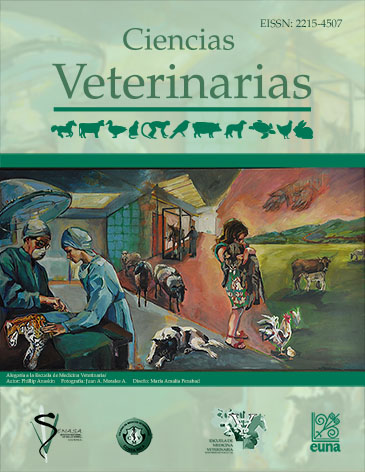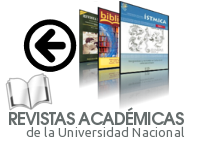First report of gastrointestinal parasites in Giraffes (Giraffa Camelopardalis reticulata) in captivity from Guanacaste, Costa Rica
DOI:
https://doi.org/10.15359/rcv.36-1.3Keywords:
giraffe, gastrointestinal parasites, Costa RicaAbstract
The giraffes (Giraffa camelopardalis reticulata), is a species of polygástrico ungulado, originating of the African continent whose populations in captivity have increased of exponential way. Parasitic diseases are classified as one of the main causes of mortality in this species. The objective of this work was to determine the species and / or genera of gastrointestinal parasites (PGI) in captive giraffes in Guanacaste, Costa Rica. A total of 37 fecal samples from 10 giraffes from a tourist center were analyzed. The samples were collected from January to May 2017 in four samples, except one of them, born during the study. Sampling was done at the time of defecation. The feces were transported cold at a temperature of ≈4° C, and sent to the Parasitology Laboratory of the School of Veterinary Medicine of the National University. The samples were processed by coprological techniques (Sheather, and sedimentation) to determine the presence of nematode, trematode and cestode eggs; immunological (FasTest® Crypto-Giardia Strip), to detect zoonotic parasites such as Cryptosporidium parvum and Giardia duodenalis; McMaster to determine the parasitic load (eggs per gram of feces = HPG) of the Strongylida group and the coproculture to determine the percentage of infective larvae (L3). 100 % of the giraffes analyzed were positive for PGI, the whole population having parasites of the Strongylida group. The L3 identified corresponded to 100 % Haemonchus spp., 10 % Cooperia spp. and 20 % Strongyloides papillosus. No zoonotic PGI were found. The range of HPG ranged from <50 to 625. The percentage of infective larvae of the Strongylida group identified by stool culture was 100 % (10/10) of Haemonchus spp. and 10 % (1/10) of Cooperia spp. Only one giraffe had mixed infection by Haemonchus and Cooperia. This study represents the first report of the presence of PGI in Costa Rican giraffes, and is the first to identify Cooperia spp. and Strongyloides papillosus worldwide.References
Bengis, R.G, Odening, K., Stolte, M., Quandt, S., & Bockhardt, I. 1998. Three new Sarcocystis species: S. giraffae, S. klaseriensis, S. camelopardalis, from the giraffe in South Africa. Journal of Parasitology 84(3): 562-565. doi: 10.2307/3284724
Bertelsen, M.F., Østergaard, K., Monrad, J., Brøndum, E.T., & Baandrup, U. 2009. Monodontella giraffae Infection in Wild-caught Southern Giraffes (Giraffa camelopardalis giraffa). Journal of Wildlife Diseases 45(4):1227-1230. doi: doi.org/10.7589/0090-3558-45.4.1227
Bozkurt, M.F., Alcigir, M.E., Yumusak, N., Kaya, A., Coskan, A.S. & Kutsal, O. 2009. Hydatid cysts on lungs of two african giraffe. International, Sciences Conferences. Stara Zagora, Bulgaria.
Chakraborty, A. 1994. Occurrence and pathology of Gongylonema infection in captive wild herbivores. Veterinary Parasitology 52(1-2): 163-167. doi: doi.org/10.1016/0304-4017(94)90047-7
Delgado, E., Fonseca, I.P., Fazendeiro, I., Matos, O., Antunes, F., & Cunha, M. 2003. Cryptosporidium spp. in ruminants at the Lisbon zoo. Journal of Zoo and Wildlife Medicine 34(4): 352-356. doi: doi.org/10.1638/02-049
Elsheika, H., & Khan, N. 2011. Essentials of Veterinary Parasitology. Ed. University of Nottingham. United Kingdom.
Fukomoto, S., Uchida, T., Ohbayashi, M., Ikebe, Y., & Sasano, S. 1996. A new host record of Camelostrongylus mentulatus (Nematoda; Trichostrongyloidea) form abomasum of a Giraffe at a Zoo in Japan. Journal of Veterinary Medical Sciences. 58(12):1223-1225. doi: doi.org/10.1292/jvms.58.12_1223
Gómez, M. S., Vila, T., Feliu, C., Montoliu, I., Gracenea, M., & Fernández, J. 1996. A Survey for Cryptosporidium spp. in mammals at the Barcelona Zoo. International Journal for Parasitology 26(11): 1331-1333. doi: doi.org/10.1016/S0020-7519(96)00104-X
Goossens, E., Dorny, P., Boomker, J., Vercammen, F., & Vercruysse, J. 2005. A 12- month survey of the gastrointestinal helmints of antelopes, gazelles and giraffids kept at two zoos in Belgium. Veterinary Parasitology 127(3-4): 303-312. doi: doi.org/10.1016/j.vetpar.2004.10.013
Jiménez, A. E., Montenegro, V. M., Hernández, J., Dolz, G., Maranda, L., Galindo, J., Epe, C., & Schnieder, T. 2007. Dynamics in infection with gastrointestinal parasites and Dictyocaulus viviparous in dairy and beef cattle from Costa Rica. Veterinary Parasitology 148(3-4): 262-271. doi: doi.org/10.1016/j.vetpar.2007.06.015
Jiménez, A. E., Fernández, A., Alfaro, R., Dolz, G., Vargas, B., Epe, C., & Schnieder, T. 2010. A cross- sectional survey of gastrointestinal parasites with dispersal stages in feces from Costa Rica dairy cattle. Veterinary Parasitology 173 (3-4): 236-246. doi: doi.org/10.1016/j.vetpar.2010.07.013
Kodádková, A., Kváč, M., Ditrich, O., Sak, B., & Xiao, L. 2010. Cryptosporidium muris in a Reticulated Giraffe (Giraffa camelopardalis reticulata). Journal of Parasitology. American Society of Parasitologists 96(1): 211-212. doi: doi.org/10.1645/GE-2212.1
Krecek, R. C., Boomker, J., Penzhorn, B. L., & Scheepers, L. 1990. Internal parasites of Giraffes (Giraffa camelopardalis angolensis) from Etosha National Park, Namibia. Journal of Wildlife Diseases 26(3): 395-397. doi: doi.org/10.7589/0090-3558-26.3.395
Lim, Y. A. L., Ngui, R., Shukri, J., Rohela, M., & Mat Naim, H. R. 2008. Intestinal parasites in various animals at zoo in Malaysia. Veterinary Parasitology 157: 154-159. doi: doi.org/10.1016/j.vetpar.2008.07.015
Matsubayashi, M., Takami, K., Kimata, I., Nakanishi, T., Hiroyuki, T., Sasai, K., & Baba, E. 2005. Survey of Cryptosporodium spp. and Giardia spp. infections in various animals at a zoo in Japan. Journal of Zoo and Wildlife Medicine 36(2): 331-335. doi: doi.org/10.1638/04-032.1
Ming, Z., Zhang, L., & Zhang, L. 2010. Redescription of Monodontella giraffae Yorke et Maplestone, 1926 (Nematoda, Ancylostomatidae) from a giraffe, Giraffa camelopardalis, from Zoo in China, with a discussion on the taxonomic status of Monodontella. Acta Parasitológica 55(1): 66-70. doi: doi.org/10.2478/s11686-010-0012-8
Mukul-Yerves, J. M., Zapata-Escobedo, M. R., Montes-Pérez, R. C., Rodríguez-Vivas, R. I. & Torres-Acosta, J. F. 2014. Parásitos gastrointestinales y ectoparásitos de ungulados silvestres en condiciones de vida libre y cautiverio el trópico mexicano. Revista Mexicana de Ciencias Pecuarias 5(4): 459-469.
Nosal, P., Kowal, J., Kornas, S., Wyrobisz, A., Skotnicki, J., Basiaga, M. & Plucińska, N. E. 2016. Endoparasites of exotic ungulates from the Girraffidae and Camelidae families kept ex situ. Annals of Parasitology 62(1): 67-70. doi: doi.org/10.17420/ap6201.34
Pato, F. J., Vázquez, L., Díez-Baños, N., López, C., Sánchez-Andrade, R., Fernández, G., Díez-Baños, P., Panadero, R., Díaz, P. & Morrondo, P. 2013. Gastrointestinal nematode infections in roe deer (Capreolus capreolus) from the NW of the Iberian Peninsula: Assessment of some risk factors. Veterinary Parasitology 196(1-2): 136-142. doi: doi.org/10.1016/j.vetpar.2013.01.027
Rojas, J. 2008. Resistencia de Haemonchus spp., Trichostrongylus spp., de los bovinos a benzimidazoles (Febendazol, Abendazol), e imidazotiazoles (Levamisol), en los Fundos de la campiña de Cajamarca, Perú. Ed. Universidad de Lima, Perú.
Shorroks, B. 2016. The Giraffe: biology, ecology, evolution and behavior. Ed. Offices. Oxford, United Kingdom.
Sloss, M., Kemp, R. & Zajac, A. 1995. Veterinary clinical parasitology. 6th. Ed. Ames. Iowa. United States of America.
Tadros, G. 1964. On Chabertiella pesteri gen. et sp. nov. (Cyathostomidae) from a Giraffe and on the Validity of Chabertia rishati Akhtar. Journal of Helminthology 1(2): 109-116.
Taylor, M., Coop., R., & Wall, R. 2015. Veterinary Parasitology. 4th. Ed. Wiley Blackwell. N. Jersey, U.S.A.
Toro, A., Rubilar, L., Palma, C., & Pérez, R. 2014. Resistencia antihelmíntica en nematodos gastrointestinales de ovinos tratados con ivermectina y febendazol. Archivos de Medicina Veterinaria 46: 247-252. doi: doi.org/10.4067/S0301-732X2014000200010
Walker, M. L., & Becklund, W. W. 1971. Occurrence of a cattle eyeworm, Thelazia gulosa (Nematoda: Thelaziidae), in an imported Giraffe in California and T. lacrymalis in a native horse in Maryland. The Journal of Parasitology 57(6): 1362-1363. doi: 10.2307/3278000
Walker, J. G., Evans, K. E., Vineer, H. R., Van Wyk, J. A. & Morgan, E. R. 2018. Prediction and attenuation of seasonal spillover of parasites between wild and domestic ungulates in an arid mixed-use system. Journal of Applied Ecology: 1-11. doi: doi.org/10.1111/1365-2664.13083
Downloads
Published
How to Cite
Issue
Section
License
Licensing of articles
All articles will be published under a license:

Licencia Creative Commons Atribución-NoComercial-SinDerivadas 3.0 Costa Rica.
Access to this journal is free of charge, only the article and the journal must be cited in full.
Intellectual property rights belong to the author. Once the article has been accepted for publication, the author assigns the reproduction rights to the Journal.
Ciencias Veterinarias Journal authorizes the printing of articles and photocopies for personal use. Also, the use for educational purposes is encouraged. Especially: institutions may create links to specific articles found in the journal's server in order to make up course packages, seminars or as instructional material.
The author may place a copy of the final version on his or her server, although it is recommended that a link be maintained to the journal's server where the original article is located.
Intellectual property violations are the responsibility of the author. The company or institution that provides access to the contents, either because it acts only as a transmitter of information (for example, Internet access providers) or because it offers public server services, is not responsible.







